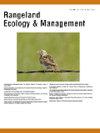缩小保护差距:保护工作需要空间定位和协调,以跟上灌木丛损失的速度
IF 2.4
3区 环境科学与生态学
Q2 ECOLOGY
引用次数: 0
摘要
尽管在整个鼠尾草生物群落中进行了大量的保护和恢复投资,但鼠尾草核心区(CSA),即具有高度鼠尾草生态完整性的斑块,仍在继续减少。从历史上看,该生物群落的保护决策是由野生生物物种的特定需求驱动的,但人们对威胁规模和生态系统退化速度的认识不断提高,迫使人们转向基于威胁的生态系统管理。因此,有必要根据生物群落面临的特定威胁所造成的退化或损失速度来评估保护实施的规模,以评估是否存在保护赤字。为此,我们1) 量化并比较了每年实施的保护措施的平均公顷数与每种威胁造成的 CSA 损失公顷数;2) 评估了核心鼠尾草区、生长机会区和其他牧场区的保护措施的相对数量;3) 评估了需要增加多少保护措施才能阻止 CSA 的减少。然后,我们量化了更好的空间定位和加强协调可如何减少未来所需的额外保护总量,并评估了大量资源的涌入可如何缩小保护差距,即抵消年度损失和退化所需的保护与实施保护的能力之间的差距。我们发现,目前的保护率(如每年处理的公顷数)明显低于 CSA 损失率(年均损失的 10%)。此外,大多数保护行动(某些处理类型的 90% 以上)都发生在 CSA 以外,这可能会降低这些保护行动在保留和恢复完整的鼠尾草牧场方面的效果。此外,我们发现保护工作需要每年增加一个数量级以上(至少 10 倍)才能阻止 CSA 的减少。然而,通过更好地确定保护行动的空间目标,阻止 CSA 减少所需的保护工作增幅可减少 70% 或更多。这项分析表明,在就保护目标、利益相关者合作以及战略性资源增加等问题做出关键决策之前,等待鼠尾草生物群落的可能是不同的未来。本文章由计算机程序翻译,如有差异,请以英文原文为准。
Closing the Conservation Gap: Spatial Targeting and Coordination are Needed for Conservation to Keep Pace with Sagebrush Losses
Core sagebrush areas (CSAs), patches of high sagebrush ecological integrity, continue to decline despite significant conservation and restoration investments across the sagebrush biome. Historically, conservation decisions in the biome have been driven by wildlife species-specific demands, but increasing recognition of the scale of threats and the pace of ecosystem degradation has compelled a shift towards threat-based ecosystem management. Therefore, there is a need to evaluate the scale of conservation implementation relative to the rate of degradation or loss from specific threats to the biome to assess whether a conservation deficit exists. To this end, we: 1) quantified and compared the average hectares of conservation practices implemented annually relative to the hectares of CSA loss attributed to each threat; 2) evaluated the relative amount of conservation actions in core sagebrush areas, growth opportunity areas, and other rangeland areas; and 3) assessed how much additional conservation may be needed to stop CSA declines. We then quantified how better spatial targeting and enhanced coordination might reduce the total additional amount of future conservation needed, and evaluated how an influx of resources can close the conservation gap, or the deficit between the conservation needed to offset annual loss and degradation and the capacity for conservation implementation. We found that current rates of conservation (e.g., hectares treated annually) are markedly lower than rates of CSA loss (∼10% of average annual loss). Furthermore, most conservation actions, ∼90% for some treatment types, occurred outside of CSAs likely reducing the efficacy of these conservation actions at retaining and restoring intact sagebrush rangelands. Additionally, we found that conservation efforts will need to increase by more than an order of magnitude (at least 10x) annually to halt CSA declines. However, through better spatial targeting of conservation actions, the increase in conservation needed to stop CSA loss could be reduced by 70% or more. This analysis demonstrates the divergent futures that may await the sagebrush biome pending key decisions regarding conservation targeting, stakeholder cooperation, and the strategic addition of resources.
求助全文
通过发布文献求助,成功后即可免费获取论文全文。
去求助
来源期刊

Rangeland Ecology & Management
农林科学-环境科学
CiteScore
4.60
自引率
13.00%
发文量
87
审稿时长
12-24 weeks
期刊介绍:
Rangeland Ecology & Management publishes all topics-including ecology, management, socioeconomic and policy-pertaining to global rangelands. The journal''s mission is to inform academics, ecosystem managers and policy makers of science-based information to promote sound rangeland stewardship. Author submissions are published in five manuscript categories: original research papers, high-profile forum topics, concept syntheses, as well as research and technical notes.
Rangelands represent approximately 50% of the Earth''s land area and provision multiple ecosystem services for large human populations. This expansive and diverse land area functions as coupled human-ecological systems. Knowledge of both social and biophysical system components and their interactions represent the foundation for informed rangeland stewardship. Rangeland Ecology & Management uniquely integrates information from multiple system components to address current and pending challenges confronting global rangelands.
 求助内容:
求助内容: 应助结果提醒方式:
应助结果提醒方式:


